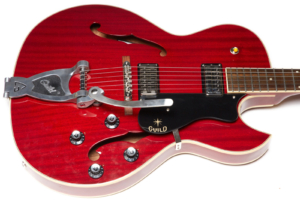
As you may be aware, I’m a hardcore US-made Guild freak, so if you’re wondering how this Guild Newark Street Starfire III is going to hold up to this cantankerous old bastard who’s not afraid to tell it like it is, read on, ’cause it’s reviewin’ time!
Introduction
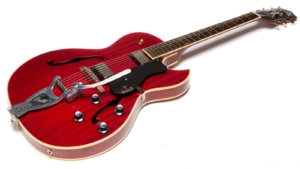
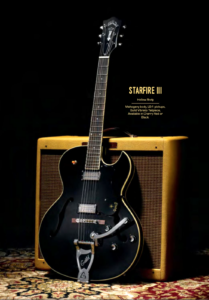
The 2016 Guild catalog shows a full page of the Starfire III leaning against a tweed amp which I’d have to imagine would be a pretty sexy combination both in looks and sound. The Guild website lists the retail price for this guitar as $1,555 in early 2019, and in the same year, used prices seem to be roughly half that number or just a touch higher.
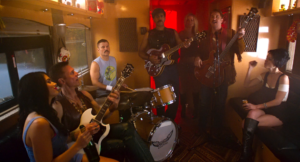
I don’t know if the Guild cameos are a product placement thing or someone in the production was a fan of Guild, but there is a thank you in the production credits to Cordoba Music Group with no specific mention of Guild.

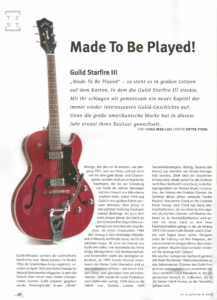
The Guild website has a product-reviews section which linked to a review from the German Gitarre & Bass Magazine which praises the Starfire. The article is in German, but the Guild page has a translation of part of it, which is naturally full of praise.
I find it interesting that the Guild website has never linked to any of my reviews. Actually, it doesn’t surprise me since I’ve been known to tell the sometimes unflattering truth which, by the way, is not something that magazines tend to do since they’re beholden to advertisers. Ever see an ad on my page? Now you know why. Well, really it’s because I loathe ads of any kind, but the fact that no one pays for my content makes my reviews more legitimate, at least in my mind.
The case
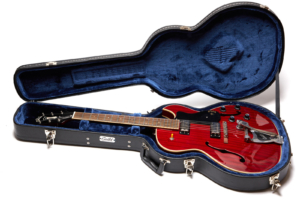
I have to say that the case is pretty nice! It’s arguably not as good as the Westerly-era cases or the Fender custom shop cases, but the case does the job with no real complaints from me. It’s also a hell of a lot better than the minimalistic case that my 1966 Starfire III case came in which offered very little protection.
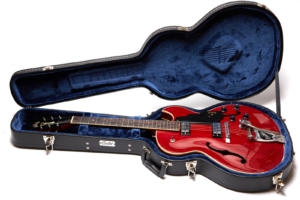
Finish
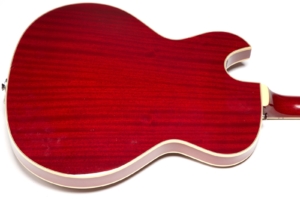
The 2016 catalog doesn’t list color options, but the Guild Website in 2019 lists the only color options as Cherry Red or Black.
Fretboard and Neck
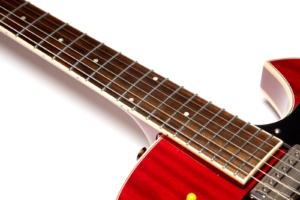
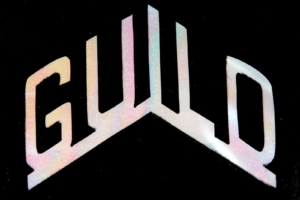
I should note that the two other Newark St. guitars currently in my possession (T-Bird ST and T-Bird ST-P90) do not have this opalescent logo and instead look more like a traditional inlay, though on closer inspection they are also a bit opalescent but with much cleaner edges and a much whiter appearance over all. Those two guitars are 2017 models while this Starfire III is a 2016 model, so that may have something to do with it, though it may also just be normal variation in whatever material it is they’re using.
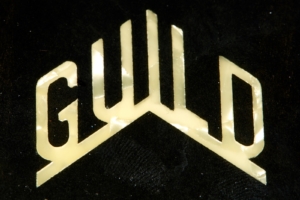
Does that matter? Well, it adds credence to the argument that the import Guilds are not “just as good” as the vintage Guilds, though to be fair the headstock veneer is a cosmetic feature more than one that affects playability or tone. It is, however, one of the methods that can be used to discern an import Guild from a US-made Guild, should you ever doubt the veracity of a Starfire being sold as vintage.
This guitar does not have a volute where my ’66 Starfire III does, but a lot of people hate them and the volute came and went on different year Hoboken Starfires, anyway, so that’s not something that anyone should be concerned about. The neck measures almost exactly the same as two other Newark St. Guilds that I have which makes sense if they’re carving them on CNC machines. Consistency is a good thing. 
The frets measured .06″ high by .09″ wide which is also par for the course with Newark St. Guilds. Guild describes the neck shape as a soft U in their spec sheet, which I disagree with as the guitar in my hands has a pretty typical C shape. To be fair, the specs may have changed between 2016 (this guitar) and 2019 (the spec sheet), but Guild isn’t really well-known for keeping their spec sheets up to date. I will say that regardless of my quibble about the shape that I love the feel of the neck. Since it’s a bit deeper than my ’66, I dare say I like it more than that vintage model. Sacrilege, I know.
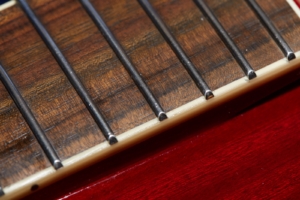
The neck is the soul of the guitar when it comes to feel and playability, and the neck on this Korean Guild delivers in a pretty satisfying way.
Build Quality
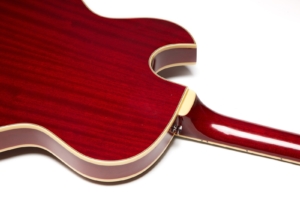
Having three other US-made Guild Starfires to compare it to, this guitar is most closely related to the 1966 Starfire III, and the build, look, and feel is pretty similar. It doesn’t have that special something that vintage guitars have, but the target demographic of this guitar may not have ever experienced that mojo (for lack of a better word) and thus wouldn’t miss it. I have, and I really only bemoan its absence when playing them side-by-side. That’s saying something, and if you’re not good at reading into things, it’s saying that this is a remarkable guitar for the money.
The top on this hollow body guitar is 3-ply laminate and measures 3/16″ (4.75mm) thick. When measuring and photographing the top, I noticed that the parallel bracing actually traverses the pickup routes which means that they had to be cut into in order to allow for the pickups to be inserted. This is very different than my ’66 Starfire where the braces are completely to the side of the routes and thus required no alteration.
This Starfire III weighs 6 lbs 3.6 oz (2.82 kilos) and is actually lighter than my ’66, though not by much.
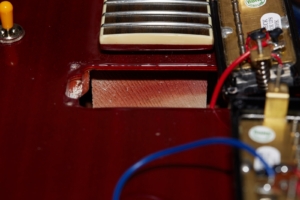
I have tempered my disappointment, though, because I’m comparing this guitar to a single sample from 1966 and other vintage samples may have been made similarly. Also, this wasn’t a problem until I pulled the pickups and saw it, so I may have just spent two paragraphs tilting at windmills.
Pickups
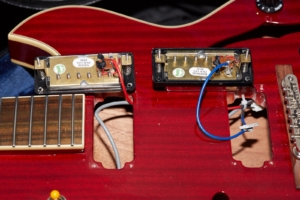
I fully expected to hate the pickups given their odd resistance readings, but I must confess that at first I had no problems with this guitar like I did with the T-Bird that has the same pickups. That really surprised me because I was really annoyed by the behavior of the mismatched pickups in my T-Bird (and my other T-Bird) and that behavior didn’t seem to happen in this guitar when playing clean. I’m even more bothered by the fact that I can’t explain that, but it does help me to reconcile the fact that so many people don’t have problems with the mismatched pickups if they somehow work better in Starfire-type guitars.
I did, however, absolutely notice the mismatch when playing with some drive, because the bridge pickup just doesn’t have the magic bite of my ’66. The neck pickup responds admirably, but the bridge pickup is a bit anemic when driven hard and that sucks because driving the bridge pickup hard is a big part of what makes all my other Starfire IIIs great.
To be perfectly clear, I like the pickups; I just don’t like how the pickups are balanced.
Electronics
After pulling the wiring harness from my 1966 Starfire III and knowing what a huge pain in the ass that was, I decided to just order a spare harness from Guild and examine that. This harness is the same for the Newark Street Starfire III, IV, and CE100D, has a SKU of 009-9120-049 and cost me $49.99 in 2019. I bought one and proceeded to cut away all of the shrink wrap tubing to get at the tasty capacitors within so I could draw a nice wiring diagram without taking apart another Starfire. I’m not committed (though I probably should be committed); I’m just so lazy that spending fifty bucks and waiting four days for delivery seemed like less of a burden than spending the hour it would have taken me to do any real work. And then I had to sit and trace the wires in the harness, anyway! Hey, at least now I have a spare harness that I’ll never ever need. Bonus!
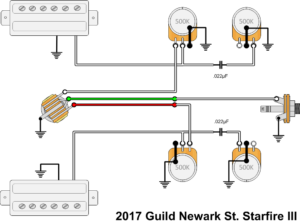
The entire assembly is made in Korea as are all the components. If you look at the wiring diagram you may notice that all of the wires are white except for a couple coming from the toggle switch. This coloring is accurate and is because of some clever wiring in the harness.
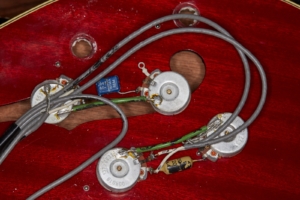
On the Newark Street harness, they smartly used a 4-conductor cable from the switch to one of the volume pots. That 4-conductor wire (red, green, white, and braided ground) is then connected to individual wires that are routed to the other set of pickup controls. This makes routing and maintenance much simpler and likely lowers cost when considered over thousands of guitars. While the build it better than it needs to be part of me likes the old Westerly wiring, the build it efficiently part of me appreciates the Korean wiring.
Hardware
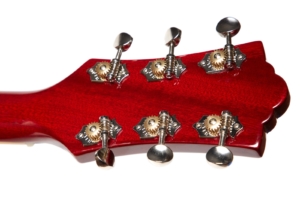
The pickguard drives me crazy. It’s too high and it annoys me. That may be why the Guildsby has that goofy plastic bit on the end from the factory because it comes in contact with the pick guard when abused. Sure, you shouldn’t be abusing the Guildsby, but if you’ve ever met me then you know I abuse everything in order to test its limits. It’s just who I am.
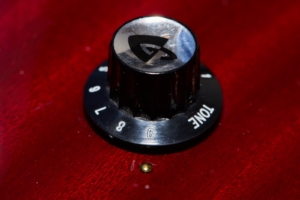
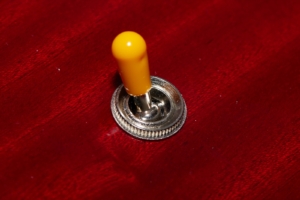
Sound
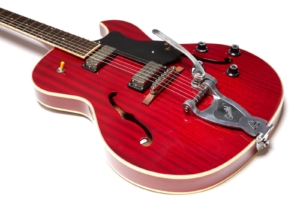
I’ve read a lot of people online who have this guitar and absolutely love it, and I can see why – it’s a pretty great guitar, especially for the money. The problem with the pickup balance is well known and I’ve covered it in great detail again and again, and again, so let me explain why this guitar is crippled by the pickups while also sounding great. It all comes down to how you play it.
ODS100 Clean
D-Shape
Rockabilly Hot Rod
Stray Cat Strut Ending
Sleepwalk
’49 Mercury Blues
12th Fret Riffage
SuperTweed
Rocky Horror
Riffage
HiWatt
Locomotive Breath
Van Halen
Panama
I’ve tried everything I can think of to give Guild the benefit of the doubt and on some of my NS Guilds I have the bridge pickup slammed up to the strings and the neck pickup way down low in an attempt to balance them out. It doesn’t work. If you’ve never experience what a guitar like this should sound like, though, you’ll never know what you’re missing, and that’s why so many of us in the Guild community are annoyed at Guild for not fixing this. These guitars sound good, but they should sound amazing.
After playing the ’66 SFIII for a week or so straight, I’m struck by the anemic nature of the bridge pickup on this guitar. Remember, this guitar has a ~5k bridge pickup with a ~7k neck pickup, and while I wasn’t bothered by that when I first picked up up this guitar, after comparing it with the guitar it’s supposed to be an homage to, this pickup imbalance really shows.
As usual, for these recordings I used my normal Axe-FX III through the QSC K12 speaker recorded direct into my Macbook Pro using Audacity. I started my normal recordings using the ODS100 Clean patch, but spent most of my time with this guitar in a preset called Rockabilly Hot Rod which is shown. The amp for that preset is based on a Brownface Vibrolux. The Stray Cat recording is using the middle position with both pickups selected, while the Sleepwalk and ’49 Mercury Blues are recorded both using just the bridge pickup. Note that these are both using the same amp setting! The only thing different is the delay which is higher for Sleepwalk. The crunch you hear in ’49 Mercury Blues is from me digging in with a heavier attack.
I also recorded a couple with the SuperTweed preset because I really dug the tone. The SuperTweed is not a real amp, but rather more of a Tweed Deluxe on steroids that exists within the realm of the Axe-FX. With the bridge pickup selected I got a real P90 into a Deluxe vibe that I just loved.
If you’re wondering why there’s a Van Halen example, it’s to match the recordings i did with the ’66 Starfire. I will also be reviewing a 1997 and 2002 Starfire and will put all four of them head to head with the same recordings.
Playability
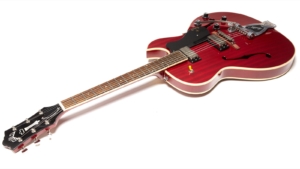
This guitar is not as lively feeling as my ’66 or my ’97 or even my ’02 Starfire IIIs, and after taking all of the detailed photos and examining the guitar, I’m leaning toward blaming the block under the neck for that. It could just be that this is an import mass-production guitar whereas the other three were all US-made guitars with lower production numbers and dedicated factories, but the scientific part of my brain is screaming that without proof that’s nothing more than a personal bias. I should point out that the other three guitars are 17, 22, and 53 years old while this one is only three, so that may be a factor as well.
Still, that difference in liveliness isn’t a huge thing and if you’ve never played any of those older guitars you’d not have any idea of there being something better. That’s sort of an awkward way of saying that this guitar actually performs pretty well, and I’d argue that it performs better than its price would suggest.
The fretwork is excellent, but the nuts can use some love on many Newark Street Guilds. The fretboard material isn’t as nice as the other Guilds in my stable, but for the price I have no complaints. Honestly, the only time this guitar really falls down is when I compare it to US-made Guilds. Well, except for the pickups.
Conclusion
I’ll again be honest and state that I expected this guitar to be sub-par. It’s not. In fact, for the money I paid for it, the guitar is pretty great. Is it a hand-made American instrument from the glory days of Guild? No. Does it matter for the price? Not really, but that really depends on what you’re paying for it.
For what they charge for these new, I’d still find a Westerly or Corona Starfire III instead. The biggest caveat in the ’90s and ’00 Starfires when compared to the Newark St. model is that the Millennial Starfires have the AntiHum or LB1 pickups, so they have a very different vibe.
Since I routinely see these Newark Street Guilds sell used in mint condition for half of their retail price, they’re a steal at that price, and if you’re after that ’60s guitar vibe for not a lot of money, it’s hard to go wrong with this guitar.
Let’s be real – this is a Korean copy of an iconic guitar, but it’s a Korean copy made under the watchful eye of the company that owns the rights to that iconic guitar, and I’m going to go ahead and say that they did the original justice.
This guitar would be a slam dunk if they’d just fix the damn pickups.
Donate: PayPal Crypto:
ETH: 0x0AC57f8e0A49dc06Ed4f7926d169342ec4FCd461
Doge: DFWpLqMr6QF67t4wRzvTtNd8UDwjGTQBGs

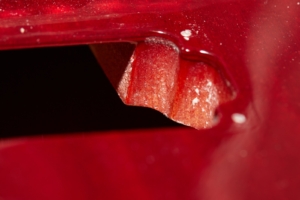
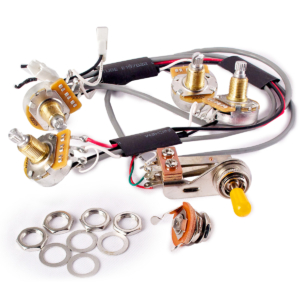
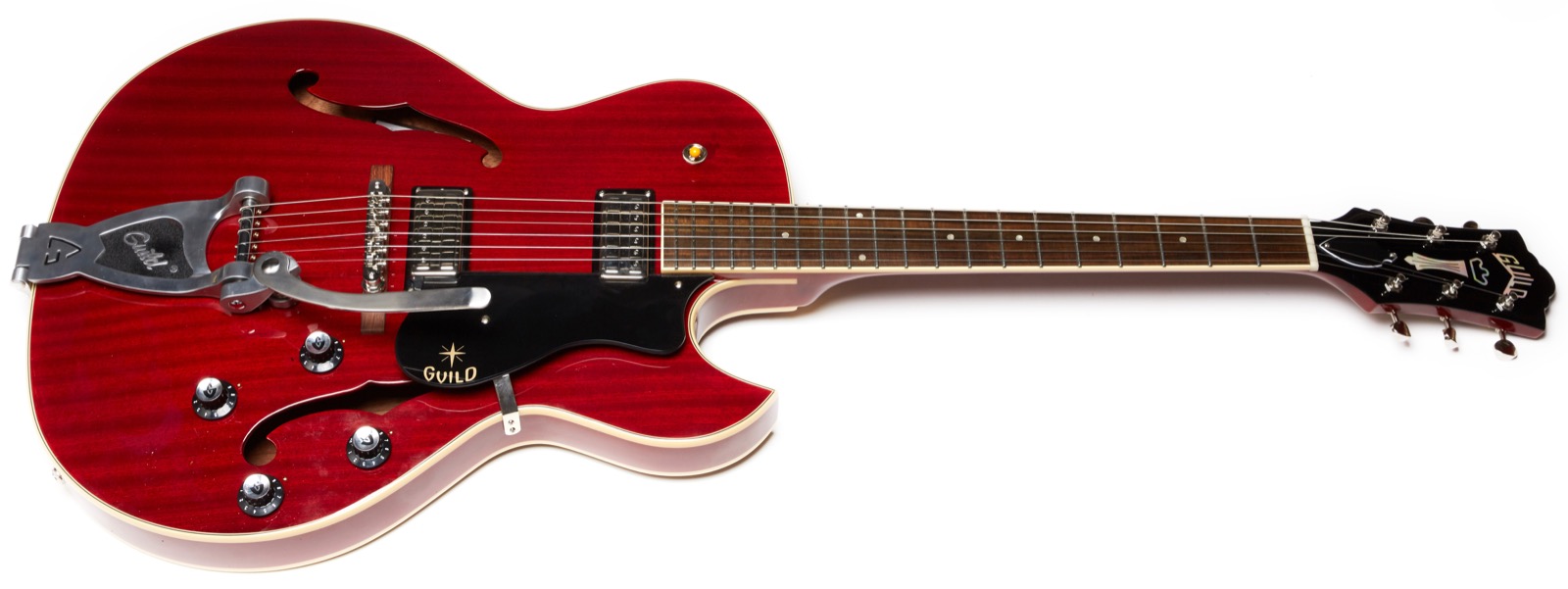
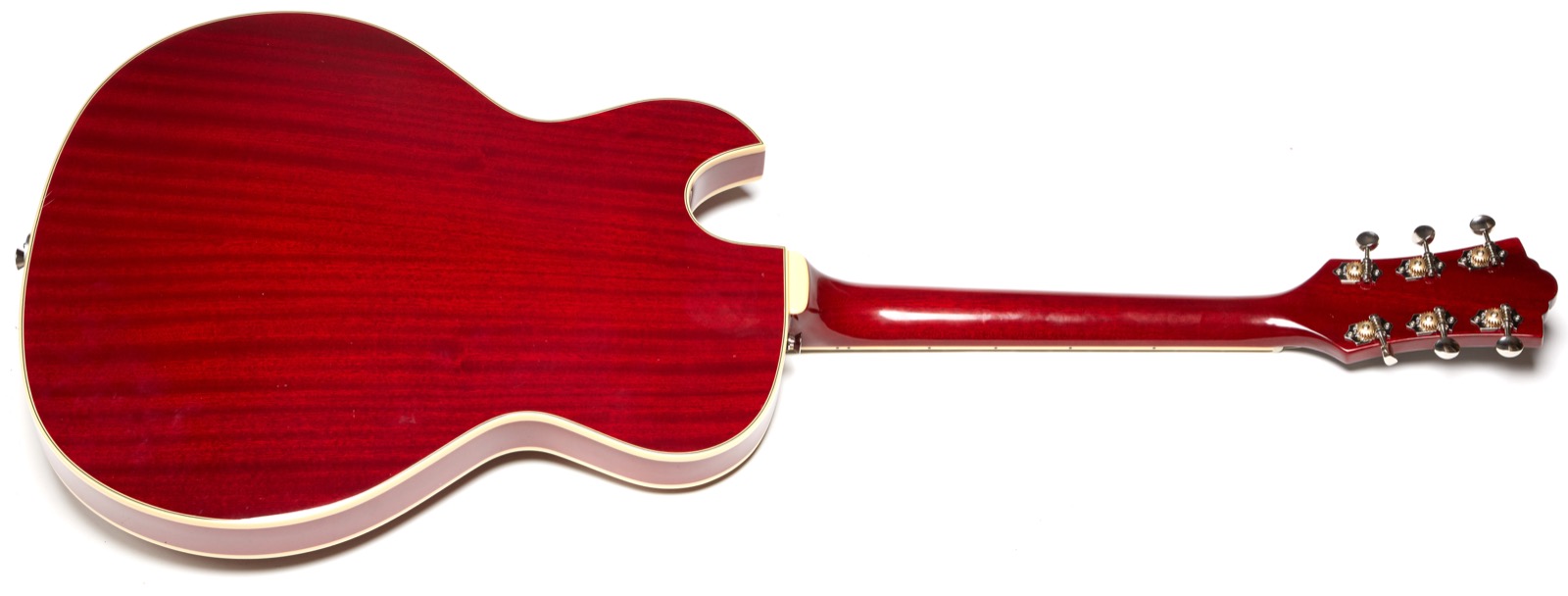
… MMMMH….. Your Rhytm Job In the Locomotive Breath Sample it’s NOT correct, IMO …..
Duly noted
I looooved this review. This is exactly the sort of deep detail I think about when I consider other guitars. One question: you ever try flipping the neck and bridge pickups around? I haven’t read many of your reviews, so maybe you have. Either way, maybe something to try. Cheers!
Thanks! I’ve not tried flipping the pickups because that would put the pole pieces out of alignment. Also I no longer have the guitar. 🙂
Thank you for your honest and in-depth evaluation of the NS Starfire III, GAD. You went to an incredible amount of work for this and I for one truly appreciate it.
So far, I fall into the category of “no problems” with the mismatched pickups. I say “so far” because I am relatively new to this guitar and have mainly played on the clean side and have yet to put it through its paces. I will be keeping a watchful ear to it as time goes on. (I am annoyed by a sloppy/loose pickup switch though)
Again, superb review!
You seriously should be paid. This is one of the most well written and concise reviews of any guitar I have ever read. (But it is obvious you have a passion for Guild guitars…:-) That said, I read your review of the ‘66 Starfire, too. Whoever edits your stuff is pro and it you edit your own writing…well I think Mark Twain has a commentary about that…but I digress.
Thank you for taking the time. I’ve purchased a recent build Starfire III (probably 2019) via eBay and it is the first guitar I’ve bought without first playing it. I bought it based on several YouTube demos and well, the price. Pretty much stuck to solid bodies in the (holy shit) 50 some years I’ve been playing, so yeah.
Anyway, like I said; thanks and good show!
Hello!
As usual, I am late to the party. First off, I thoroughly enjoyed this well-written review. You clearly share my passion for Guild guitars. I recently purchased a Korean Starfire IV ST online. It plays beautifully but is the absolute worst sounding guitar in my substantial arsenal. I am not a hobbyist in that I play 12-15 gigs a month. I have decided to simply pull the pickups and replace them with something that fits. So, that is actually my question. Do you know if something like a mini humbucker would fit in it’s place. Or something else? Absent a direct fit replacement I will probably sell this guitar and use something else. My other Guilds include a rare 2002 X180 Park Avenue (Corona – one of 95 built) , a ’97 Bluesbird and a Westerly Starfire IV
Anu thoughts would be greatly appreciated. Thank you in advance.
Nice Guilds! What is it about the sound that you don’t like? If it’s just the pickups you can try swapping them to get the higher-output pick in the bridge, though the pole pieces won’t line up. I generally like the sound of the pickups – it’s the imbalance that kills me.
I’ve not tried mini-hums, but Guild AntiHums from the ’60s would fit. MiniHums from Gibson are 2 5/8″ x 1 1/8″ while AntiHums are 2 13/16″ x 1 5/16″ (same size as LB1s).
Great article. I like my Starfire IV, Newark street model. The bridge pickup is unacceptable… so, I sent it off to Tom Brantley (tombrantleyrewinds.com) to rewind it… I’m having him wind it 8.3Kohm… I expect the guitar to be significantly better once I get it back and reinstalled. The neck pickup is awesome, soon the bridge will be too. For $92 bucks I consider that a steal…
I’ll be installing a new wiring harness using Vintage Inspired pots, Mallory caps, and upgraded switch… having to try to source US knobs will be difficult, but I’ll just put some Gibson knobs on until I can find them… with the rear pickup rewind I expect the guitar to be much improved tonally.
@TNRICH have you received your rewound pickup? I’m considering this but have no idea what to expect as far as an improvement. Others have said swapping them or buying another neck pickup as alternatives as well.
Not even sure the guy sees this. No reply button for him 🙁
Thanks for the posts GAD. Bought one of these SF 3s and the pickups are frustrating, especially as a first experience with Guild. But read this post and a bunch of others here beforehand so had an idea what I was getting. Enjoy your writing style btw.
Good Afternoon from Napa — I purchased a Guild Starfire 2 earlier this year (Newark) it was mint (Still is) and it came with a fine HSC – I paid $500.
First – I utterly hate the Guild Newark Tuners and the Starfire 2 Tuners are a step down from the Grover Starfire Tites in the Newark Blues Bird. I was also getting a little sitar buzz in the nut – something that probably only I could hear.
I dropped in Sperzel EZ 8.5mm tuners. They have a lower profile and the strong hole is far near the actual head face. This creates a sharper string bend — the guitar simply feels far improved that angle took away the Sitar “E” and the tuners (12/1) are smooth and accurate.
I like the Lil Buckers — (I play rather Clean) They are a good compliment to the My Hamer 2004 with Lollars my TV Jones Supreme with of course TV Jones pups.
The record well going direct.
I have smallish hands – I love the neck as well.
I recommend this guitar if you can find it tax free with a HSC to anyone .. The new Tuners. HSC and the actual guitar cost me a total of $575
I also should mention that I bought a Bluebird (Newark) for just over $500… I actually love that guitar.. Neck Yes, Your Duncan Pup — Yes… Tuners Big No – Look YEs… (PICKGUARD ehh..) Mine was one of the early ones that is coil tapped as well.
Thank you for your reviews … I read them greedily as I decided on a couple of Guilds.
Thank you GAD for that in-depth review.
I purchased a used Guild Newark Street Starfire III from a local gentleman, just a few weeks ago.
I must say that your review was what got me off the fence over buying the guitar.
It’s a 2022 model, and the previous owner just didn’t bond with it.
He’s more of an acoustic guy, admittedly.
Anyway, this Starfire III is just fabulous.
I’m loving it, a lot.
I’m taking to it a LOT more than the ES-335 style guitars I have held, and maybe a bit more than the Ibanez jazz boxes I have owned in the past.
Thanks again.
I’ve got my beady eye on a used one of these in black. Full price in UK is approx £1,100 and used £ 800 ish. Having read your detailed review I feel better armed to make an objective purchasing decision, which can be pretty tricky in a shop environment.
Keep up the good work. Many thanks
I’ve got one of these. Adjusting pickup screws really help with balance. I bring down the A and E Strings a couple few turns on the neck and same but up a couple turns on the bridge. Sounds great. No need to swap imo. These pickups bark with some sparkle and I like them.
The problem I have is with the bridge. I’ll sometimes pop the high e for effect and I keep pulling it out of the saddle. I believe a Compton is in my future.
I have a Korean Starfire V. I don’t know if the Cordova music LB-1 picks are different, but I bought mine when they first came out and Fender owned guild. The pick ups are terrible. They remind me of the fake wide range humbuckers that Fender puts on their Telecaster Deluxe. They look cool, but sound like Doodoo. Can’t understand how anyone can like them. I want to get mine rewound.
Wish you could do a review of the Sweetwater Limited edition of the Starfire III with ebony board, all maple body , DeArmond dynasonics, and in Emerald Green.